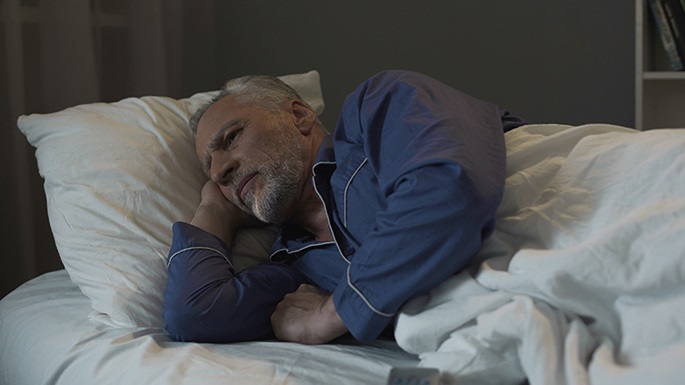The amount of sleep we need changes as we age.
Both sleep duration and quality tend to decline as we grow older. While infants typically need the most rest, older adults need the least, and sleep may be fragmented in later life, as well.
Getting a good night’s sleep becomes more difficult at the beginning of adulthood. Why do sleep needs shift from seventeen hours each night in infancy to seven or less in old age? Physical and mental developments and fluctuations in the body’s natural rhythm cause the architecture of sleep to change over time.
Why does sleep change as we age?
A healthy sleep-wake cycle regulates individualized bed and wake times, causing feelings of sleepiness at night and alertness in the morning. The cycle is sensitive to environmental and physiological changes, and recalibrates in response to fluctuations in body chemicals, lifestyle choices, and health conditions.
The sleep-wake cycle may change with age as the body produces less of the sleep-promoting hormone melatonin. Decreasing levels of growth hormone can lead to a decline in deeper sleep. Lifestyle habits more common in adults like consuming caffeine can also affect sleep quantity.
Infants experience long periods of sleep that may total seventeen hours a day. Extended sleep periods in infancy allow for sustained release of human growth hormone, which stimulates muscle and bone growth.
During the aging process, the body and brain go through fewer physiological changes and sleep often becomes less restorative. Possible reasons include decreased release of melatonin and less time spent in deep N3 sleep.
Age and sleep stage variations
Typical sleep consists of four stages:N1 (light sleep), N2 (deeper stage), N3 (deep sleep), and REM (rapid eye movement sleep associated with dreaming).. During N1, N2, and N3, breathing and heart rate slow, blood pressure declines, and the sleeper is relatively still. By contrast, REM sleep closely resembles being awake. The eyes move rapidly, and brain waves are similar to those that occur in the waking brain.
Babies spend most of their sleep time in the deep, slow-wave sleep of N3. Slow-wave sleep gradually decreases throughout childhood, while REM sleep increases. Further declines in slow-wave sleep in adulthood and old age may result in lighter, more fragmented rest with frequent awakenings.
General sleep recommendations by age
The National Sleep Foundation recently created sleep range recommendations based on age:
New-borns (14-17 hours)
Healthy new-borns typically spend most of the 24-hour day asleep. Rest is usually sporadic until they establish a regular circadian rhythm that produces melatonin at the same time each night. A new-born baby may sleep eight to 12 hours at night and accumulate the additional hours through naps.
Infants (12-15 hours)
After three to four months, infants begin to develop a sleep pattern that becomes consolidated into longer periods. As infants reach their first birthday, they typically sleep through the night and take multiple daytime naps.
Toddlers (11-14 hours)
Toddlers nap less often and their sleep becomes more consolidated at night. The toddler stage may be a time of temporary or persistent sleep difficulties, including bedtime resistance, night time awakenings, difficulty falling back to sleep, and nightmares. Many experts advise parents to keep a consistent bedtime routine to help prevent sleep problems, and early intervention with a child sleep specialist should they develop.
Pre-schoolers (10-13 hours)
When kids reach pre-school age, napping continues to decline. The risk of sleep problems may increase. These issues often include resisting bedtime, asking to sleep with parents, wanting to continue a fun activity, and waking up frequently at night.
School-age children (9-11 hours)
By the age of six or seven, many children stop taking naps. Sleep typically happens in a single consolidated block at night. Kids in this age group spend a lot of their sleep in slow-wave sleep, or deep and restorative rest, meaning they are usually very alert and energetic during the day.
Teenagers (8-10 hours)
Adolescents may experience a sleep phase delay due to natural circadian rhythm changes. This shift causes teens to feel alert later at night and makes it difficult to fall asleep. Because most school start times are much earlier than a teenager’s preferred wake time, many students do not get enough rest. Some might develop a circadian rhythm disorder called delayed sleep phase syndrome (DSPS).
Younger adults (7-9 hours)
As people enter their early twenties, they spend more of their time in lighter sleep stages and less time in deep, refreshing sleep. As a result, young adults often feel less rested after waking up and may experience daylight sleepiness.
Adults (7-9 hours)
Adults need 7-9 hours of sleep per night. Genetic factors and individual chronotype help determine how much rest is needed within this range. However, 1 in 3 American adults doesn’t get enough sleep. Lifestyle factors such as caffeine consumption, work and school demands, parenting, stress, and jet lag may contribute to this sleep deficit.
Older adults (7-8 hours)
The elderly often experience sleep problems such as less restorative sleep, difficulty falling asleep, and frequent awakenings throughout the night. Various causes contribute to potential sleep problems later in life, such as decreased melatonin production or chronic sleep and medical problems.
